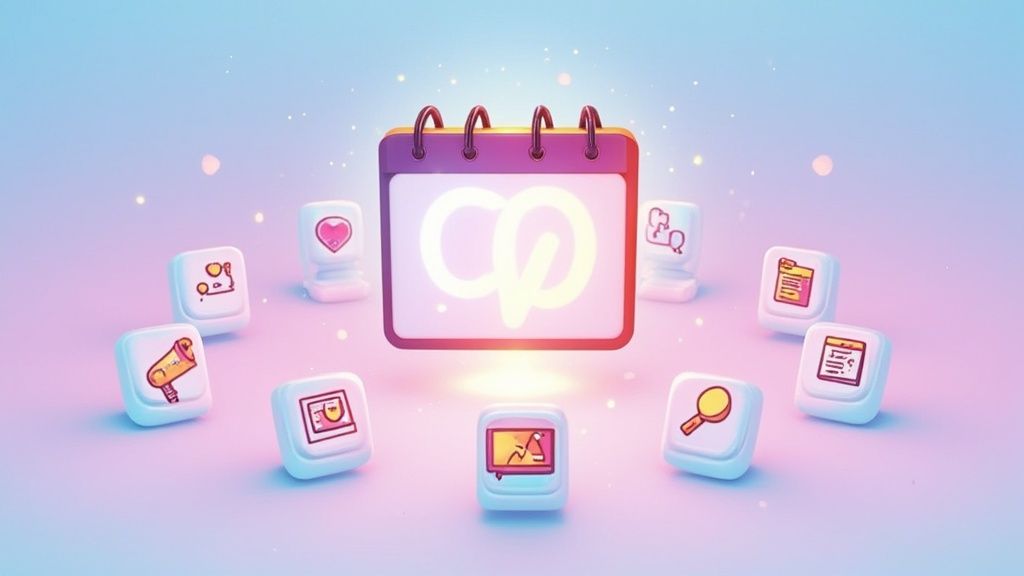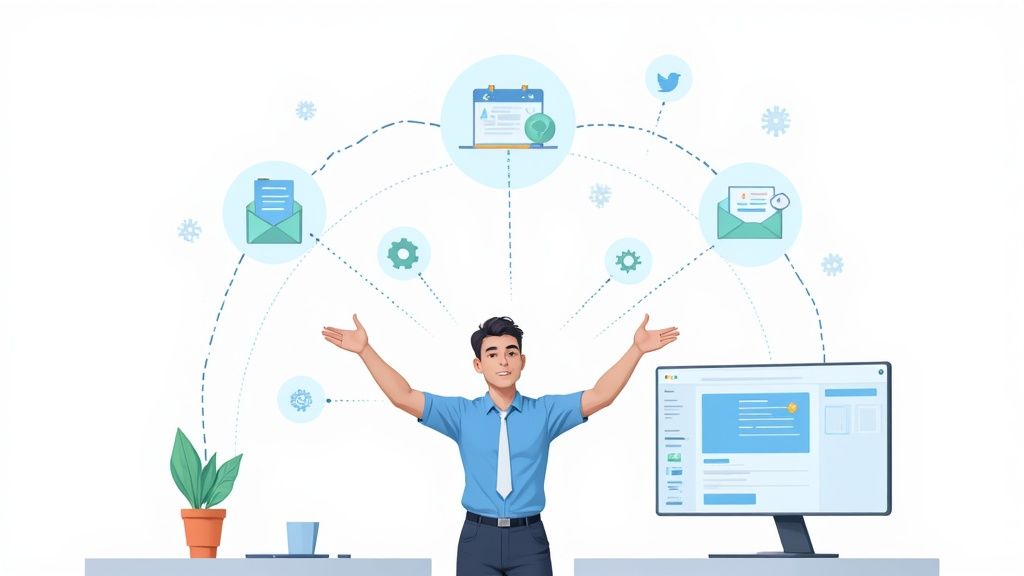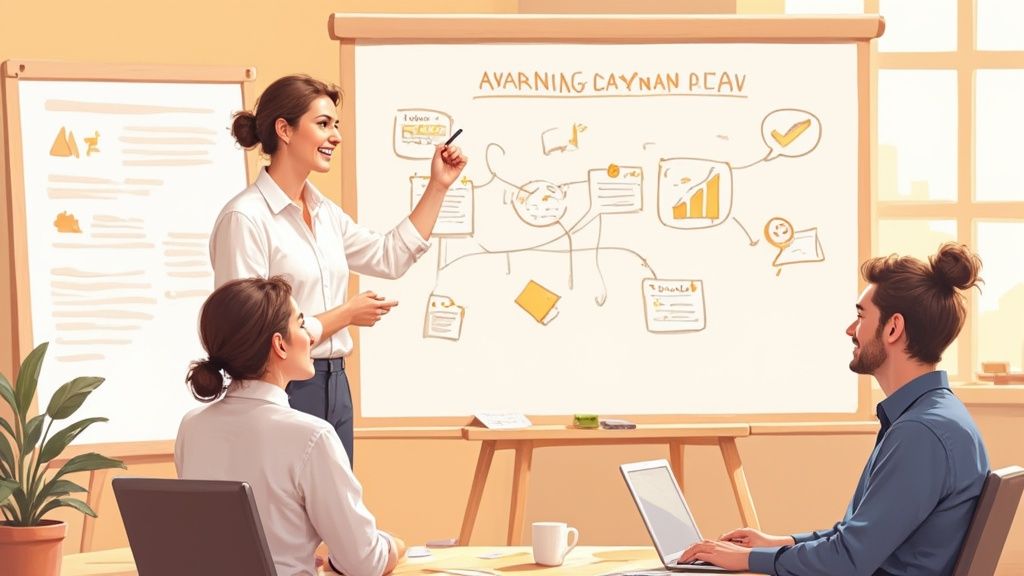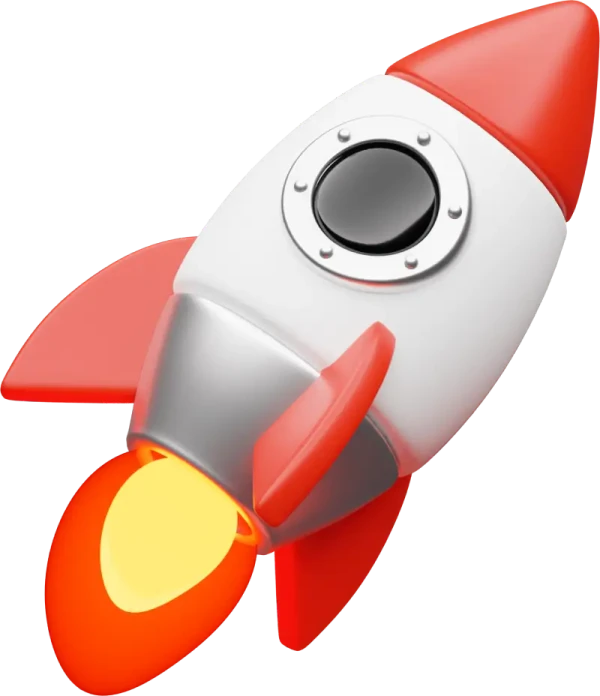In the crowded landscape of 2025, generic event promotion falls flat. Attendees crave more than just a date on the calendar; they seek memorable experiences, genuine connections, and tangible value. Moving beyond traditional tactics is no longer optional, it's essential for capturing attention, driving registrations, and ensuring your event is the one people talk about long after it's over. To truly reinvent your approach and go beyond conventional methods, it's crucial to understand and implement effective event marketing strategies that resonate with modern audiences.
This guide explores a curated collection of innovative event marketing ideas designed to break through the noise. We will delve into actionable strategies that cover the full event lifecycle, from pre-launch buzz to post-event engagement. You will discover how to build anticipation, create immersive moments, and foster lasting relationships with your attendees.
We will cover specific, practical tactics, including:
- Crafting interactive experience zones that captivate and engage.
- Leveraging gamification to drive participation and friendly competition.
- Building authentic connections through influencer partnerships and community-focused events.
- Using storytelling to create a powerful narrative that sticks with your audience.
Each idea is packed with real-world examples, practical implementation tips, and insights on how to seamlessly integrate these concepts into your marketing workflow. Get ready to transform your approach from a simple announcement to a compelling invitation, ensuring every event you host is a resounding success. This list provides the fresh perspective needed to make your next event truly unforgettable.
1. Interactive Experience Zones
Interactive Experience Zones transform passive attendees into active participants. These dedicated spaces move beyond simple product displays, creating immersive, hands-on environments where guests can experiment, play, and engage directly with your brand. By offering a memorable, sensory-rich experience, you forge a much deeper connection than a standard sales pitch ever could. This is one of the most powerful event marketing ideas for creating lasting brand recall.
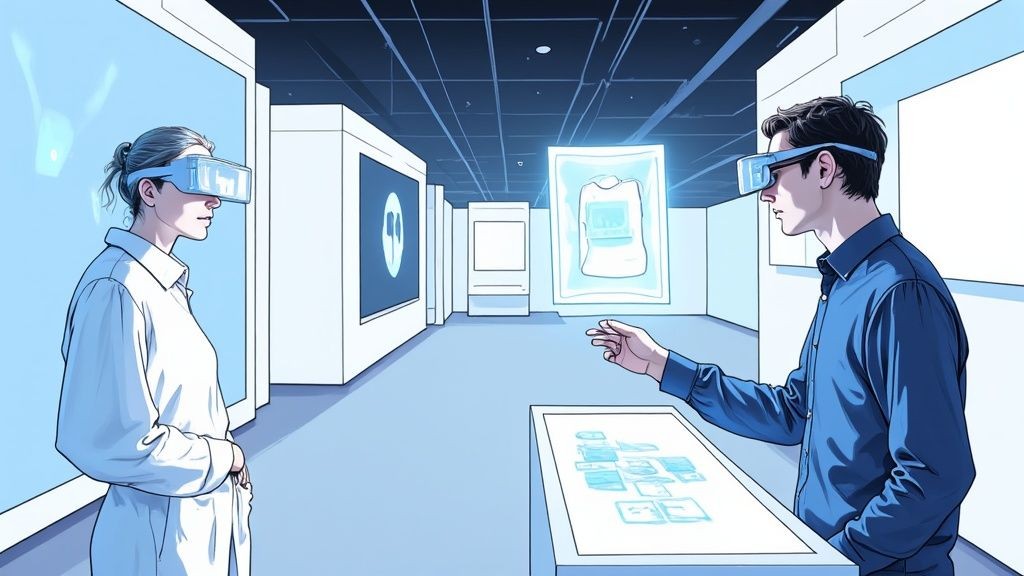
This strategy works because it taps into the human desire for discovery and participation. Instead of just hearing about a product's features, attendees can see, touch, and use it in a dynamic setting. The goal is to generate genuine excitement and create a positive emotional association with your brand.
How to Implement Interactive Zones
Successful execution requires a blend of creativity, technology, and strategic planning.
- Technology Integration: Leverage tools like augmented reality (AR) for virtual try-ons, virtual reality (VR) for immersive simulations, or interactive touchscreens for personalized content exploration. For example, a tech company could create a VR station allowing attendees to "walk through" a new software interface.
- Hands-On Activities: Focus on tactile engagement. A food brand might set up a DIY topping bar, or an automotive company could offer a driving simulator. Coca-Cola's personalized bottle stations are a classic example, turning a simple product into a unique, shareable keepsake.
- Gamification: Introduce a competitive or playful element. This could be a digital leaderboard tracking scores from an interactive game or a physical challenge with prizes. The key is to make engagement fun and rewarding.
Key Insight: The most effective experience zones are not just about showcasing a product; they are about creating a story or solving a problem for the attendee. The interaction should provide value, whether through entertainment, education, or personalization.
To ensure your zones generate buzz, design them to be visually striking and "Instagram-worthy." Encourage social sharing by creating obvious photo opportunities and branded hashtags. This amplifies your reach far beyond the event floor. Finally, integrate a method for lead capture, such as requiring an email signup to access the experience, allowing for targeted follow-up marketing.
2. Hybrid Event Marketing
Hybrid Event Marketing merges the best of both worlds, combining a live, in-person event with a virtual, online component. This dual approach creates a unified experience that drastically expands your reach beyond physical attendees, allowing you to engage a global audience while still fostering the valuable connections of a face-to-face gathering. It is one of the most adaptable and scalable event marketing ideas for maximizing impact in the modern landscape.
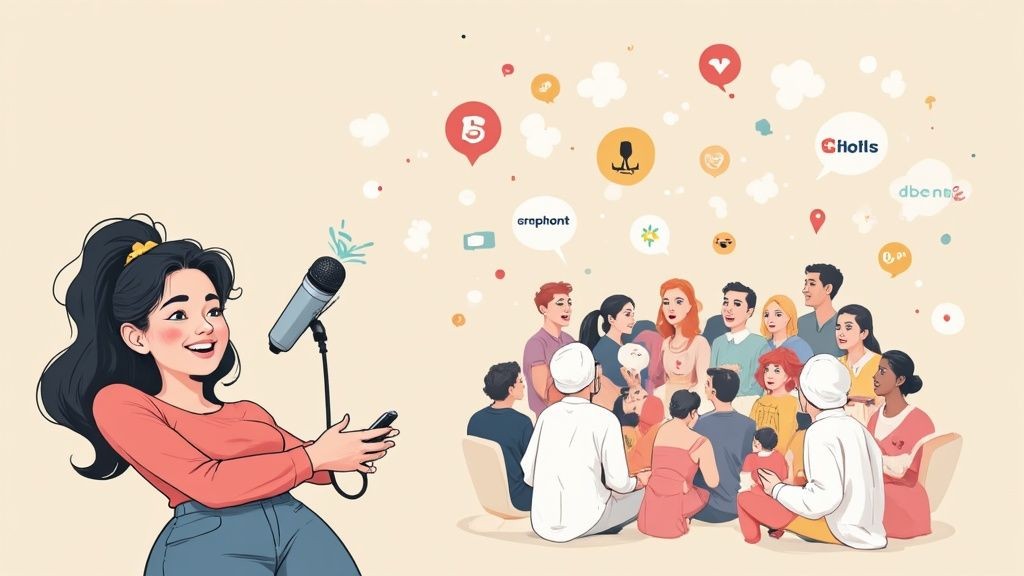
This strategy works because it offers unparalleled flexibility and accessibility. Participants can choose the format that best suits their budget, location, and comfort level, which significantly lowers the barrier to entry. Major events like Salesforce's Dreamforce and Adobe Summit have successfully used hybrid models to engage hundreds of thousands of participants, demonstrating its power to build a massive, inclusive community.
How to Implement Hybrid Event Marketing
A successful hybrid event requires thoughtful planning to ensure both audiences feel equally included and engaged.
- Invest in Reliable Technology: High-quality streaming is non-negotiable. Use a professional platform with multi-camera setups, clear audio, and minimal latency to provide a seamless viewing experience for the virtual audience. Test everything rigorously beforehand.
- Create Unified Content: Design content that translates well to both formats. Use interactive tools like live polls, Q&A sessions, and shared chat rooms that allow in-person and virtual attendees to interact with each other and with speakers in real-time.
- Designate Dedicated Moderators: Have separate community managers or moderators for your in-person and virtual audiences. This ensures that questions from the online chat are addressed promptly and that both groups feel seen and heard.
Key Insight: A true hybrid event is not just a live stream of an in-person conference. It's about intentionally designing a cohesive experience where the virtual and physical components are interconnected and add value to one another.
To maximize engagement and streamline communication, consider incorporating event marketing automation. This can help manage registrations, send tailored reminders to both audience segments, and deliver on-demand content post-event. By automating these logistical tasks, you can focus more on creating a memorable and valuable experience for every single attendee, regardless of how they join.
3. Influencer Partnership Events
Influencer Partnership Events leverage the credibility and reach of social media personalities to generate authentic buzz and drive attendance. By collaborating with influencers who align with your brand, you tap directly into a pre-built community of engaged followers. This strategy transforms standard event promotion into a trusted recommendation from a familiar voice, making it one of the most effective event marketing ideas for building credibility and amplifying your message.
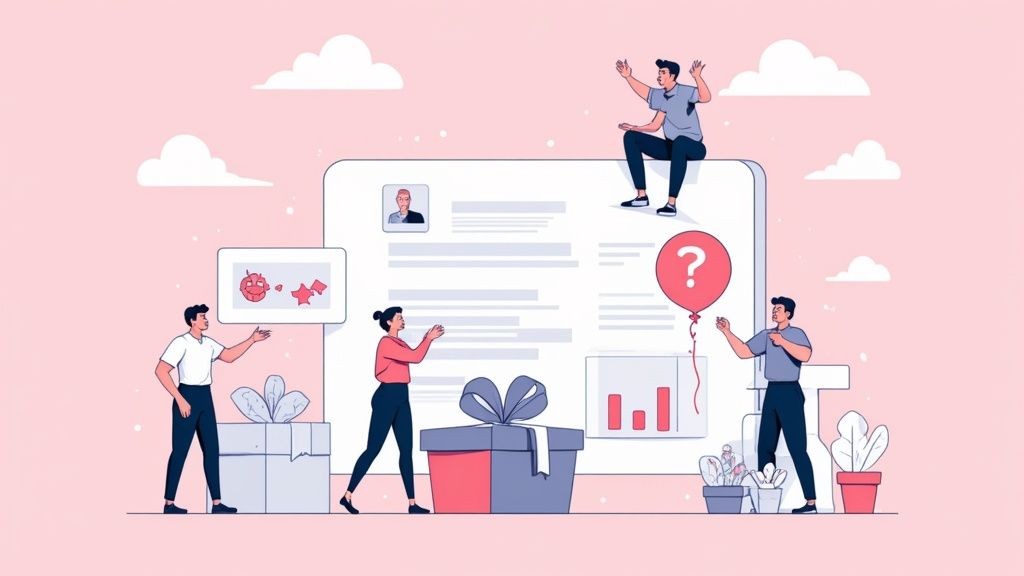
This approach works because it harnesses the power of social proof. An influencer's endorsement feels more like a genuine suggestion than a traditional advertisement. When followers see a creator they admire attending or co-hosting your event, it creates a powerful sense of FOMO (fear of missing out) and validates your event's value, encouraging ticket sales and organic social media conversation.
How to Implement Influencer Partnerships
A successful influencer event requires strategic selection, clear communication, and a focus on mutual value.
- Strategic Selection: Don't just chase follower counts. Choose influencers whose audience demographics and brand values mirror your own. A fitness brand should partner with a health and wellness creator, not a generic celebrity. Authenticity is key; the partnership must feel natural to their audience. For instance, Revolve's success with the Revolve Festival is built on deep-rooted relationships with fashion influencers who genuinely represent their brand aesthetic.
- Exclusive Experiences: Make influencers feel like true VIPs. Provide them with exclusive access, unique content opportunities, or a special role in the event, like hosting a Q&A session. Brands like Sephora excel at this by creating intimate "Beauty Insider" events where creators can preview products before the public.
- Clear Guidelines and Goals: Set clear expectations for deliverables, such as the number of posts, stories, or videos. Equip them with a media kit containing key messages, branded hashtags, and essential event details. Track engagement metrics like reach, likes, comments, and link clicks to measure ROI and refine future collaborations.
Key Insight: The best influencer partnerships are not transactional; they are relational. Focus on building long-term relationships with creators who are genuine fans of your brand. This fosters authentic advocacy that extends far beyond a single event campaign.
To maximize your efforts, integrate your influencer campaign with other event promotion ideas on add-to-calendar-pro.com. Ensure the content created is easily shareable and visually compelling to encourage user-generated content from the influencer's followers. By treating influencers as collaborative partners, you turn their audience into your own.
4. Gamification and Competition Elements
Gamification and Competition Elements infuse your event with a sense of play, challenge, and reward, dramatically boosting attendee engagement. This strategy involves integrating game-like mechanics such as points, badges, leaderboards, and challenges into non-game contexts. By tapping into our natural instincts for competition and achievement, you can guide attendee behavior, encourage participation in key activities, and create a more dynamic and memorable experience. It’s one of the most effective event marketing ideas for fostering interaction and collecting valuable data.
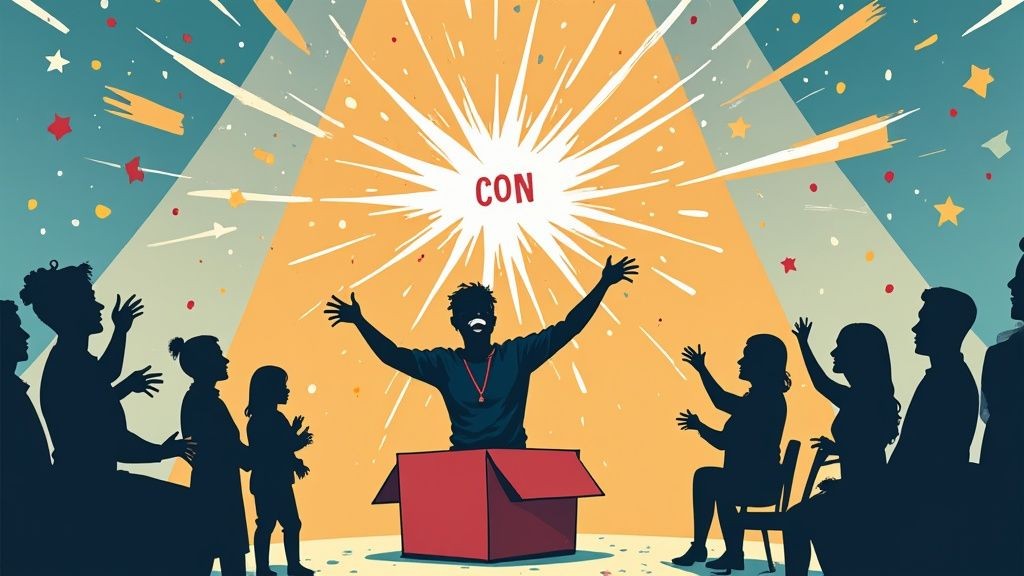
This approach works by transforming routine event actions, like visiting exhibitor booths or attending sessions, into steps within a larger, more exciting game. Attendees are no longer passive observers but active players working towards a goal. The result is increased foot traffic to desired areas, higher session attendance, and more meaningful networking connections, all driven by a spirit of friendly competition.
How to Implement Gamification
A successful gamification strategy is carefully aligned with your event's core objectives and designed to be intuitive for all attendees.
- Define Clear Objectives: Start by identifying what you want to achieve. Do you want to increase social media mentions, drive traffic to sponsor booths, or encourage networking? Design challenges that directly support these goals. For example, Salesforce’s Dreamforce uses its Trailhead platform to guide attendees through specific learning paths with badges and points.
- Simple and Accessible Rules: The game should be easy to understand and participate in. Use a mobile event app to host scavenger hunts, trivia, or photo challenges where attendees earn points for completing tasks. Comic-Con often employs scavenger hunts that lead attendees to various exhibitors, increasing booth visibility.
- Offer Meaningful Rewards: Prizes should be desirable and relevant to your audience. This could range from branded merchandise and gift cards to exclusive experiences like a VIP dinner with keynote speakers. The value of the reward should match the effort required.
Key Insight: The best event gamification is not just about winning; it's about enhancing the attendee journey. The activities should add value by encouraging discovery, learning, and connection, making the core event experience more enriching and enjoyable.
To maximize impact, display a live leaderboard in a high-traffic area to fuel the competitive atmosphere and keep participants engaged. Promote the game before the event to build anticipation and clearly explain the rules and rewards. Finally, analyze the participation data afterward to gain insights into attendee behavior, identify popular activities, and measure the ROI of your engagement efforts.
5. Surprise and Delight Campaigns
Surprise and Delight Campaigns leverage the power of the unexpected to create powerful, memorable moments for attendees. Instead of following a predictable event schedule, this strategy introduces unanticipated elements like secret guests, unannounced product reveals, or exclusive gifts. The goal is to evoke strong positive emotions such as joy, excitement, and gratitude, which attendees will then associate directly with your brand. These moments are among the most effective event marketing ideas for generating authentic social media buzz and word-of-mouth promotion.
This strategy works by disrupting expectations and creating a peak experience. When an attendee receives an unexpected benefit, it feels like a genuine gift rather than a calculated marketing tactic. This builds a deep sense of loyalty and makes them feel personally valued. Think of Oprah's famous "You get a car!" giveaway or Apple's iconic "One more thing..." announcements; these moments are legendary because they create an electrifying, shared experience.
How to Implement Surprise and Delight Campaigns
A successful surprise requires meticulous planning behind the scenes to ensure a seamless and impactful reveal.
- Unexpected Giveaways: Go beyond standard swag. Offer high-value, exclusive items to a select few or even all attendees. This could range from a surprise gift card under every seat to a drawing for a grand prize that wasn't advertised. The key is the element of surprise.
- Secret Guests: Bring in a surprise celebrity, industry influencer, or even a well-known athlete to make an appearance. Nike has mastered this by having superstar athletes show up unannounced at local sporting events, creating an unforgettable experience for participants.
- Exclusive Reveals: Use your event as the stage for a surprise announcement. This could be a new product feature, a major company partnership, or a limited-time offer available only to those in attendance. This rewards your live audience and makes them feel like insiders.
Key Insight: The success of a surprise campaign is directly tied to its authenticity and alignment with your brand. The surprise should feel like a natural extension of your brand's personality, not a random gimmick. It must enhance the attendee experience, not distract from the event's core purpose.
To maximize impact, ensure the surprise is timed strategically, perhaps during a lull or as a grand finale. Have cameras ready to capture the genuine reactions of your audience, as this footage becomes powerful content for future marketing campaigns. Lastly, keep the secret tightly under wraps; a leaked surprise loses nearly all of its emotional power.
6. User-Generated Content Campaigns
User-Generated Content (UGC) campaigns turn your attendees into brand advocates. This strategy encourages participants to create and share their own content, such as photos, videos, and testimonials, about your event. By leveraging their personal networks, you amplify your event's reach organically and build a library of authentic promotional material that resonates far more powerfully than traditional advertising.
This approach works by capitalizing on social proof and authenticity. Content created by attendees is perceived as more trustworthy and genuine, providing an unbiased endorsement of your event. Seeing friends and peers enjoy an experience is a powerful motivator for others to attend in the future, making UGC a cornerstone of modern event marketing ideas.
How to Implement UGC Campaigns
A successful UGC campaign is built on clear incentives and easy participation.
- Create Branded Hashtags: Develop a unique, memorable, and easy-to-spell hashtag for your event. Promote it heavily before, during, and after the event on all marketing materials. This consolidates all user content into a single, searchable stream. Coachella's iconic festival hashtags are a prime example of this in action.
- Design "Shareable" Moments: Intentionally design visually appealing spaces like photo booths, branded backdrops, or unique art installations that compel attendees to take and share photos. The more "Instagrammable" your event is, the more content will be generated.
- Incentivize Participation: Offer clear reasons for attendees to share. This could be a contest for the "best photo" with a valuable prize, a digital leaderboard, or simply the chance to be featured on your brand's official social media channels. Starbucks' annual #RedCupContest is a masterclass in incentivizing mass participation.
Key Insight: The most effective UGC campaigns make sharing feel like a natural and rewarding part of the event experience, not a marketing chore. Focus on creating genuine moments of delight that attendees will be excited to capture and post.
To maximize your campaign's impact, actively monitor your event hashtag and engage with user posts by liking, commenting, and re-sharing. This interaction shows appreciation and encourages more people to contribute. Further insights into the role of user-generated content in content marketing can provide additional strategies for your campaigns. Finally, prominently feature the best UGC on your website, social media, and future promotional materials to showcase the vibrant community around your event.
7. Exclusive VIP Access Programs
Exclusive VIP Access Programs elevate the standard event experience by offering a tiered level of service to a select group of attendees. These programs create an atmosphere of exclusivity and reward your most valuable customers, partners, or influencers with special privileges. By providing premium perks, you not only generate a high-margin revenue stream but also build a powerful sense of community and loyalty around your brand.
This strategy works by leveraging the psychological principle of scarcity and status. When access is limited, its perceived value increases. Attendees who opt for a VIP package feel recognized and special, which enhances their emotional connection to the event and your brand. It's a highly effective event marketing idea for deepening relationships with key stakeholders.
How to Implement a VIP Program
A successful VIP program is defined by the tangible value and unique experiences it offers.
- Offer Tangible Perks: Go beyond a simple "VIP" label. Offer concrete benefits like front-row seating, dedicated fast-track entry, exclusive networking lounges with complimentary food and drinks, or private Q&A sessions with keynote speakers. Music festivals excel at this, offering access to air-conditioned rest areas and premium viewing platforms.
- Create Exclusive Content or Access: Provide access to people or places that general attendees cannot reach. For example, Tesla hosts exclusive events for owners, offering them early access to new technology and direct interaction with engineers. Fashion Week's front-row seating is a classic example of providing unparalleled access.
- Deliver Premium Service: Ensure the VIP experience feels genuinely premium from start to finish. This includes having a dedicated concierge or guest services team trained to cater to VIP needs. The service itself is as much a part of the product as the access.
Key Insight: True exclusivity is not just about better amenities; it's about providing unique access and experiences that cannot be replicated. The goal is to make VIPs feel like true insiders, not just customers who paid for a better ticket.
Clearly define and communicate the benefits of your VIP package during the promotion phase to drive sales. Use this tier to gather high-quality feedback from your most engaged audience, which can be invaluable for future event planning. A well-executed VIP program can transform attendees into passionate brand advocates.
8. Storytelling and Narrative Marketing
Storytelling and Narrative Marketing transforms your event from a simple gathering into a compelling journey. Instead of presenting facts and figures, this approach weaves a narrative around your brand, product, or cause, creating an emotional connection with your audience. By using story arcs, thematic elements, and relatable characters, you make the event’s message far more engaging, memorable, and impactful. This is one of the most resonant event marketing ideas for building genuine brand loyalty.
This strategy works because humans are hardwired to respond to stories. A well-told narrative can capture attention, evoke empathy, and simplify complex ideas, making your message stick long after the event concludes. The goal is to align your brand’s purpose with your audience's values, creating a shared experience that feels personal and significant. To truly resonate with your audience and create memorable event experiences, consider delving deeper into the power of effective storytelling in marketing.
How to Implement Storytelling
A successful narrative-driven event requires authenticity, consistency, and a deep understanding of your audience.
- Develop a Core Narrative: Define the central story you want to tell. Is it a hero’s journey, a story of community impact, or a tale of innovation? For instance, Patagonia frames its events around environmental activism, making attendees part of a larger mission.
- Use Multiple Formats: Tell your story across various channels and mediums. Use compelling keynote speakers like TED Talks do to share "ideas worth spreading," create video testimonials from customers, or design physical installations that walk attendees through a timeline.
- Integrate Across All Touchpoints: Your narrative should be woven into every element of the event, from pre-event email invitations and social media campaigns to the stage design, session content, and post-event follow-up. This creates a cohesive and immersive experience.
Key Insight: The most powerful event narratives are not about your brand being the hero; they are about positioning the attendee as the hero. Your brand or product should act as the guide or tool that helps them achieve their goals, overcome a challenge, or become part of a meaningful cause.
To maximize impact, ensure your story is authentic and aligns with your brand's true values. Audiences can easily spot an inauthentic narrative. Encourage user-generated content by asking attendees to share their own stories related to the event's theme, turning them into active participants in the brand’s evolving story.
9. Community Building Events
Community Building Events shift the focus from a one-time transaction to fostering long-term relationships. Instead of pitching products, these events are designed to connect attendees with each other, creating a network built on shared interests, professional goals, or brand values. By positioning your brand as the facilitator of these meaningful connections, you cultivate a loyal following that sees your organization as a central pillar of their community.
This strategy works because it addresses a fundamental human need for belonging. When people feel part of a group, their loyalty and engagement skyrocket. These events transform your audience from passive consumers into active brand advocates who contribute to, and draw value from, the community you've helped create. This is one of the most sustainable event marketing ideas for building lasting brand affinity.
How to Implement Community Building Events
Successful execution requires prioritizing connection over conversion and providing continuous value.
- Facilitate Meaningful Interactions: Move beyond generic networking. Use structured activities like themed breakout sessions, "ask me anything" panels with industry leaders, or peer-to-peer problem-solving workshops. For example, GitHub's developer conferences are not just about new features; they are about connecting coders to solve real-world problems together.
- Focus on Attendee Value: Your primary goal should be to help attendees connect and grow. Offer content and activities that serve their needs, not just your sales targets. Salesforce's Trailblazer Community events are a prime example, empowering users to learn from each other and advance their careers, which in turn deepens their loyalty to the Salesforce ecosystem.
- Create Ongoing Touchpoints: The event is the catalyst, not the conclusion. Keep the conversation going with an online forum, a dedicated Slack channel, regular newsletters, or smaller, recurring meetups. This maintains momentum and solidifies the community's foundation between major events.
Key Insight: True community building is not about selling; it is about serving. When you genuinely invest in your audience's success and connections, brand loyalty and advocacy become the natural byproducts.
To support these events, create a dedicated online hub where members can connect before, during, and after. An effective event landing page is crucial for communicating the community-focused vision and encouraging registration. You can explore some highly effective event landing page examples on add-to-calendar-pro.com to see how to frame your event. Always listen to community feedback to shape future events and initiatives, ensuring the community feels heard and valued.
Event Marketing Ideas Comparison Matrix
| Event Marketing Strategy | Implementation Complexity 🔄 | Resource Requirements ⚡ | Expected Outcomes 📊 | Ideal Use Cases 💡 | Key Advantages ⭐ |
|---|---|---|---|---|---|
| Interactive Experience Zones | High – tech integration, training | High – space, tech, staff | High engagement, memorable brand experiences | Product launches, brand awareness, tech conferences | Multi-sensory engagement, social content, feedback |
| Hybrid Event Marketing | Very High – complex tech setup | High – streaming, specialized staff | Expanded reach, scalable attendance | Corporate conferences, product launches, trade shows | Global accessibility, cost-effective scale, data insights |
| Influencer Partnership Events | Medium – influencer coordination | Medium – influencer fees, content | Extended targeted reach, authentic engagement | Fashion, beauty, lifestyle, music festivals | Credibility, user content, cost-effective marketing |
| Gamification and Competition | Medium – game design and tech | Medium – planning and prizes | Increased engagement, extended interaction | Corporate events, trade shows, product launches | Engagement boost, social sharing, data collection |
| Surprise and Delight Campaigns | High – careful planning, logistics | High – cost of surprises, talent | Strong emotional impact, buzz generation | Product launches, brand activations, award shows | High memorability, viral potential, emotional connection |
| User-Generated Content Campaigns | Low to Medium – social campaign management | Low – social tools, monitoring | Authentic brand advocacy, extended reach | Festivals, brand activations, product launches | Cost-effective content, organic reach, long-term assets |
| Exclusive VIP Access Programs | Medium – premium service setup | Medium to High – perks, operations | Premium revenue, brand loyalty | Luxury events, corporate conferences, fashion shows | Higher revenue, exclusivity, enhanced perception |
| Storytelling and Narrative Marketing | Medium to High – creative expertise | Medium – content creation | Strong emotional engagement, memorable messaging | Brand activations, corporate events, cause-related | Emotional connection, retention, differentiation |
| Community Building Events | High – ongoing management | Medium to High – facilitation, resources | Strong loyalty, recurring participation | Professional conferences, networking, industry meetups | Sustainable growth, valuable insights, word-of-mouth |
Turning Ideas Into Attendance: Your Next Steps
We've journeyed through a powerful collection of event marketing ideas, each designed to transform a standard gathering into an unforgettable experience. From the immersive allure of Interactive Experience Zones and the broad reach of Hybrid Event Marketing to the authentic connection forged through Influencer Partnerships, the path to a sold-out event is paved with creativity and strategic execution. The core lesson is clear: modern attendees crave more than just a presentation; they seek participation, connection, and a story they can become a part of.
The most successful event marketers understand that ideas like Gamification, Surprise and Delight campaigns, and User-Generated Content initiatives are not just fleeting trends. They are fundamental shifts in how audiences engage with brands. These strategies tap into basic human desires for play, recognition, and community, turning passive attendees into active brand advocates. Your goal is no longer just to fill seats but to build a loyal, engaged community that eagerly awaits your next announcement.
Synthesizing Strategy into Action
The true challenge lies in bridging the gap between these innovative concepts and flawless execution. A groundbreaking idea can easily falter due to logistical friction or poor communication. This is where the tactical elements of your marketing plan become paramount.
Consider the journey from a potential attendee’s first interaction to the moment they arrive at your event.
- Discovery: They see your event promoted through a compelling story or an influencer they trust.
- Interest: They visit your landing page, intrigued by the promise of an exclusive VIP experience or a fun competition.
- Commitment: They decide to attend. This is the most critical conversion point.
This final step, the commitment, is where many marketing funnels break down. An attendee might be genuinely excited but gets distracted, forgets to mark their calendar, or misses a crucial reminder email. This is precisely why integrating a seamless technological backbone into your creative strategy is not just helpful, it's essential for maximizing attendance and ROI.
From Inspiration to Implementation
The event marketing ideas discussed in this article provide the "what" and the "why." Now, you need a powerful "how." The ultimate goal is to make it as easy as possible for someone to say "yes" to your event and ensure they remember that commitment. Automating the small but critical details frees up your team to focus on the bigger picture, like curating those surprise and delight moments or building authentic community connections.
Imagine launching a User-Generated Content campaign. As submissions pour in, your automated system can send a personalized thank you with an "Add to Calendar" button for the winner announcement event. Or, for your Exclusive VIP Access program, you can create a unique, password-protected event landing page and RSVP form, ensuring that only your most valued guests can register. This level of professional, streamlined execution elevates your brand and makes attendees feel secure and valued.
Mastering these approaches means you are no longer just an event organizer; you are an experience architect. You are building anticipation, fostering community, and creating value long before the event doors open. The key is to support your bold creative vision with equally robust and intelligent tools that handle the heavy lifting. By doing so, you ensure that every brilliant idea translates directly into what matters most: engaged, excited, and present attendees. Don't just plan an event; build a phenomenon.
Ready to turn these event marketing ideas into reality with seamless execution? Add to Calendar PRO provides the essential toolkit, from professional event landing pages and RSVP management to the customizable calendar buttons that ensure your event never gets forgotten. Start simplifying your workflow and maximizing attendance today by exploring Add to Calendar PRO.
